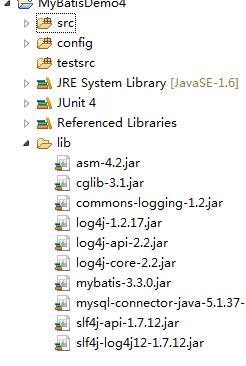MyBatis入门(三)---多个参数
一、建立表
1.1、建立表,并插入数据
/* SQLyog Enterprise v12.09 (64 bit) MySQL - 5.6.27-log : Database - mybatis ********************************************************************* */ /*!40101 SET NAMES utf8 */; /*!40101 SET SQL_MODE=''*/; /*!40014 SET @OLD_UNIQUE_CHECKS=@@UNIQUE_CHECKS, UNIQUE_CHECKS=0 */; /*!40014 SET @OLD_FOREIGN_KEY_CHECKS=@@FOREIGN_KEY_CHECKS, FOREIGN_KEY_CHECKS=0 */; /*!40101 SET @OLD_SQL_MODE=@@SQL_MODE, SQL_MODE='NO_AUTO_VALUE_ON_ZERO' */; /*!40111 SET @OLD_SQL_NOTES=@@SQL_NOTES, SQL_NOTES=0 */; CREATE DATABASE /*!32312 IF NOT EXISTS*/`mybatis` /*!40100 DEFAULT CHARACTER SET utf8 */; USE `mybatis`; /*Table structure for table `author` */ DROP TABLE IF EXISTS `author`; CREATE TABLE `author` ( `author_id` int(11) unsigned NOT NULL AUTO_INCREMENT COMMENT '作者ID主键', `author_username` varchar(30) NOT NULL COMMENT '作者用户名', `author_password` varchar(32) NOT NULL COMMENT '作者密码', `author_email` varchar(50) NOT NULL COMMENT '作者邮箱', `author_bio` varchar(1000) DEFAULT '这家伙很赖,什么也没留下' COMMENT '作者简介', `register_time` datetime DEFAULT CURRENT_TIMESTAMP COMMENT '注册时间', PRIMARY KEY (`author_id`) ) ENGINE=InnoDB AUTO_INCREMENT=10 DEFAULT CHARSET=utf8; /*Data for the table `author` */ insert into `author`(`author_id`,`author_username`,`author_password`,`author_email`,`author_bio`,`register_time`) values (1,'张三','123456','123@qq.com','张三是个新手,刚开始注册','2015-10-29 10:23:59'),(2,'李四','123asf','lisi@163.com','魂牵梦萦 ','2015-10-29 10:24:29'),(3,'王五','dfsd342','ww@sina.com','康熙王朝','2015-10-29 10:25:23'),(4,'赵六','123098sdfa','zhaoliu@qq.com','花午骨','2015-10-29 10:26:09'),(5,'钱七','zxasqw','qianqi@qq.com','这家伙很赖,什么也没留下','2015-10-29 10:27:04'),(6,'张三丰','123456','zhangsf@qq.com','这家伙很赖,什么也没留下','2015-10-29 11:48:00'),(7,'金庸','qwertyuiop','wuji@163.com','这家伙很赖,什么也没留下','2015-10-29 11:48:24'),(8,'知道了','456789','456789@qq.com','哈哈哈哈哈雅虎','2015-10-29 14:03:27'),(9,'不知道','1234567890','123456@qq.com','哈哈哈哈哈雅虎','2015-10-29 14:01:16'); /*!40101 SET SQL_MODE=@OLD_SQL_MODE */; /*!40014 SET FOREIGN_KEY_CHECKS=@OLD_FOREIGN_KEY_CHECKS */; /*!40014 SET UNIQUE_CHECKS=@OLD_UNIQUE_CHECKS */; /*!40111 SET SQL_NOTES=@OLD_SQL_NOTES */;
二、创建项目
2.1、创建项目

2.2、创建POJO类
package com.pb.mybatis.po; import java.util.Date; /** * * @Title: Author.java * @Package com.pb.mybatis.po * @ClassName Author * @Description: TODO(Blog作者类) * @author 刘楠 * @date 2015-10-29 上午9:27:53 * @version V1.0 */ public class Author { //作者ID private int authorId; //作者用户名 private String authorUserName; //作者密码 private String authorPassword; //作者邮箱 private String authorEmail; //作者介绍 private int authorBio; //注册时间 private Date registerTime; /** * @return the authorId */ public int getAuthorId() { return authorId; } /** * @param authorId the authorId to set */ public void setAuthorId(int authorId) { this.authorId = authorId; } /** * @return the authorUserName */ public String getAuthorUserName() { return authorUserName; } /** * @param authorUserName the authorUserName to set */ public void setAuthorUserName(String authorUserName) { this.authorUserName = authorUserName; } /** * @return the authorPassword */ public String getAuthorPassword() { return authorPassword; } /** * @param authorPassword the authorPassword to set */ public void setAuthorPassword(String authorPassword) { this.authorPassword = authorPassword; } /** * @return the authorEmail */ public String getAuthorEmail() { return authorEmail; } /** * @param authorEmail the authorEmail to set */ public void setAuthorEmail(String authorEmail) { this.authorEmail = authorEmail; } /** * @return the authorBio */ public int getAuthorBio() { return authorBio; } /** * @param authorBio the authorBio to set */ public void setAuthorBio(int authorBio) { this.authorBio = authorBio; } /** * @return the registerTime */ public Date getRegisterTime() { return registerTime; } /** * @param registerTime the registerTime to set */ public void setRegisterTime(Date registerTime) { this.registerTime = registerTime; } /** (non Javadoc) * <p>Title: toString</p> * <p>Description:重写toString方法 </p> * @return * @see java.lang.Object#toString() */ @Override public String toString() { return "Author [authorId=" + authorId + ", authorUserName=" + authorUserName + ", authorPassword=" + authorPassword + ", authorEmail=" + authorEmail + ", authorBio=" + authorBio + ", registerTime=" + registerTime + "]"; } }
2.3、创建configruation
<?xml version="1.0" encoding="UTF-8"?> <!DOCTYPE configuration PUBLIC "-//mybatis.org//DTD Config 3.0//EN" "http://mybatis.org/dtd/mybatis-3-config.dtd"> <configuration> <properties resource="db.properties" /> <typeAliases> <!--使用默认别名 --> <package name="com.pb.mybatis.po"/> </typeAliases> <environments default="development"> <environment id="development"> <transactionManager type="JDBC"/> <dataSource type="POOLED"> <property name="driver" value="${jdbc.driver}"/> <property name="url" value="${jdbc.url}"/> <property name="username" value="${jdbc.username}"/> <property name="password" value="${jdbc.password}"/> </dataSource> </environment> </environments> <mappers> <!-- 加载映射 --> <package name="com.pb.mybatis.mapper"/> </mappers> </configuration>
2.3、创建mapper接口
public interface AuthorMapper { /** * * @Title: findById * @Description: TODO(根据查找一个用户) * @param id * @return Author */ public Author findAuthorById(int authorId); }
2.4、创建mapper.xml
<?xml version="1.0" encoding="UTF-8"?> <!DOCTYPE mapper PUBLIC "-//mybatis.org//DTD Mapper 3.0//EN" "http://mybatis.org/dtd/mybatis-3-mapper.dtd"> <mapper namespace="com.pb.mybatis.mapper.AuthorMapper"> <!--使用resultMap映射 type使用别名,--> <resultMap type="Author" id="authorResultMap"> <!--主键 --> <id property="authorId" column="author_id"/> <!--普通属性与表中的字段对应 --> <result property="authorUserName" column="author_username"/> <result property="authorPassword" column="author_password"/> <result property="authorEmail" column="author_email"/> <result property="authorBio" column="author_bio"/> <result property="registerTime" column="register_time"/> </resultMap> <!--根据查找一个用户 --> <select id="findAuthorById" parameterType="int" resultMap="authorResultMap"> SELECT * FROM author WHERE author_id=#{authorId} </select> </mapper>
三、传入多个ID,进行查找使用List
3.1、更改Mapper接口
/** * * @Title: findAuthors * @Description: TODO(根据多个ID进行查找) * @param idLists * @return List<Author> */ public List<Author> findAuthors(List<Integer> idLists);
3.2、更改Mapper.xml
<!--根据多个ID查找 --> <select id="findAuthors" resultMap="authorResultMap"> SELECT * FROM author WHERE author_id in <foreach collection="list" item="item" index="index" open="(" close=")" separator=","> #{item} </foreach> <!-- collection:传入参数的名称 index:索引: item:collection的别名 --> </select>
3.3、测试
@Test public void testFindAuthors() { //获取会话 SqlSession sqlSession=sqlSessionFactory.openSession(); //Mapper接口 AuthorMapper authorMapper=sqlSession.getMapper(AuthorMapper.class); List<Integer> list=new ArrayList<Integer>(); list.add(1); list.add(3); list.add(4); list.add(6); list.add(7); //调用方法 List<Author> authors=authorMapper.findAuthors(list); System.out.println(authors); //关闭会话 sqlSession.close(); }
四、使用Map做为参数
4.1、在Mapper接口中增加相应方法
/** * * @Title: findAuthorsByMap * @Description: TODO(使用Map做为参数) * @param map * @return List<Author> */ public List<Author> findAuthorsByMap(Map<String, Object> map);
4.2、更改Mapper.xml
<!--使用Map查找 --> <select id="findAuthorsByMap" resultMap="authorResultMap"> SELECT * FROM author <!-- 参数使用Map的Key--> WHERE author_username LIKE "%"#{username}"%" or author_bio like"%"#{bio}"%" </select>
4.3、测试
@Test public void testFindAuthorsByMap() { //获取会话 SqlSession sqlSession=sqlSessionFactory.openSession(); //Mapper接口 AuthorMapper authorMapper=sqlSession.getMapper(AuthorMapper.class); Map<String, Object> map=new HashMap<String, Object>(); map.put("username", "张"); map.put("bio", "哈"); //调用方法 List<Author> authors=authorMapper.findAuthorsByMap(map); System.out.println(authors); //关闭会话 sqlSession.close(); for(Author a:authors){ System.out.println(a.toString()); } }
五、直接使用多个参数
5.1、Mapper接口
/** * * @Title: findAuthorsByParams * @Description: TODO(使用多个参数 * @param id * @param username * @return List<Author> */ public List<Author> findAuthorsByParams(int authorId,String authorUserName);
5.2、Mapper.xml
<!--直接使用多个参数 --> <select id="findAuthorsByParams" resultMap="authorResultMap"> SELECT * FROM author WHERE author_id=#{0} OR author_username LIKE "%"#{1}"%" <!-- 其中,#{0}代表接收的是dao层中的第一个参数,#{1}代表dao层中第二参数,更多参数一致往后加即可。 --> </select>
5.3、测试
@Test public void testFindAuthorsByParams() { //获取会话 SqlSession sqlSession=sqlSessionFactory.openSession(); //Mapper接口 AuthorMapper authorMapper=sqlSession.getMapper(AuthorMapper.class); //调用方法 List<Author> authors=authorMapper.findAuthorsByParams(6,"张"); System.out.println(authors); //关闭会话 sqlSession.close(); for(Author a:authors){ System.out.println(a.toString()); } }
六、直接使用多个参数注解写法
6.1、Mapper接口
public List<Author> findAuthorsByParams(@Param("id") int authorId,@Param("username")String authorUserName);
6.2、Mapper.xml
<!--使用注解的方式使用多个参数 --> <select id="findAuthorsByParams" resultMap="authorResultMap"> SELECT * FROM author WHERE author_id=#{id} or author_username LIKE "%"#{username}"%" <!-- 使用注解的方式。,直接使用Param中的参数即可 --> </select>







